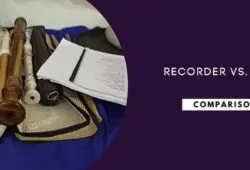Playing the flute is one of those hobbies that can carry over the generations, so you might want an instrument that will still be usable many decades down the road.
As you will come to see, a professional flute guarantees you just that.
Let’s get right to our guide that we hope it will help you find the best professional flute that suits your preferences and budget.
Table of Contents
The Best Professional Flutes Reviews In 2024
Did you know that Gemeinhardt is the largest maker of flutes and piccolos in the world?
This brand provides a ton of options to choose from, and the 3SB-NG would be an excellent choice for someone interested in a semi-professional flute.
The 3SB-NG is an evolution of the classic 3SB model, so you know that this flute will definitely not disappoint. Many people consider it to be the best professional flute.
Gemeinhardt used pure solid silver sterling for the entire construction of this flute.
The head, body, and footare all made of solid silver, but the key mechanism is silver-plated.
The solid silver construction gives this flute a beautifully rich, sweet tone with impressive resonance and tonal response.
The lip plate is gold-plated, and besides enhancing the aesthetics of the flute, this comes in handy also for allergenic purposes.
The professionally padded flute comes with stainless steel springs, hidden adjusting screws, and felt has been used in place of cork.
The flute is designed with a B-footjoint, an inline G key, and French open-hole keys, which are all features you’d want in an instrument at this level.
The flute comes with a stylish case, a case cover with a shoulder strap and a cleaning rod.
- Sterling silver construction.
- Superior quality NG1 shaped lip.
- Allergenic lip plate and riser.
- Professionally padded.
- Easy response and articulation.
- Has Y-Arm keys.
To start this flute review, I must first say that Azumi flutes are a perfect fit for the player who aspires to go pro.
One grand feature on the AZ3, as well as on all other Azumi flutes, is the Altus Z-Cut professional headjoint.
This headjoint design responds easily and quickly and is responsible for the flute’s full and rich tone.
The .925 Sterling silver construction speaks of the quality of this instrument, as do the stainless-steel springs as well.
Playing all three registers on the Azumi AZ3 is a breeze, and you play in tune just as effortlessly.
Also, the French pointed Arm keys give this instrument an elegant and refined look. Not to mention the player benefits from even pad wear and improved key strength.
Other features of this flute include B-footjoint, open hole keys, offset G key, Split E mechanism, and a Gizmo (C# trill) key.
The instrument comes with a French case and cover.
- Mid-priced professional flute.
- Sterling silver construction.
- Altus-Bennett Scale.
- Wide rib construction for enhanced durability.
- Excellent intonation.
- It’s a semi-professional flute.
Yamaha 677H flutes splendidly combine the brilliance of nickel silver keys with the characteristic warm colors of a sterling silver headjoint and body.
The headjoint on this flute is hand-finished, and it is actually a modification of the Type A headjoint that comes with Yamaha handmade flutes.
What’s more is that the headjoint, body, and footjoint of the Yamaha 677h have all been heat treated.
This is done using Yamaha’s proprietary acoustic annealing process, and the reason is to provide an impressive evenness of tone and response throughout all registers.
While playing the instrument, you are bound to appreciate the incredible response offered, as well as the impressive dynamic range.
Having a wall thickness of 0.43mm, this flute produces a remarkably warm and rich tone.
Premium quality Straubinger Phoenix Pads have been used in this Yamaha 677h to give a more precise and consistent seal on the keys.
This means that the flutist can play with a lighter touch and quicker action, making it effortless to execute faster passages.
The flute comes with a case, cover, and cleaning rod.
- Sterling silver construction.
- Annealed headjoint, body & footjoint.
- Uses top-grade Straubinger Phoenix Pads.
- Hand-finished headjoint.
- 5-Year Warranty.
- Heavyweight tubing thickness might not suit some players.
The curved headjoint of this Jupiter flute is advantageous to players with a smaller stature seeing as it allows for improved posture and greater playing comfort.
Jupiter 519S has a silver-plated nickel silver body and headjoint. While this may not have the same tonal quality as sterling silver, nickel silver has impressive durability.
However, you’d be glad to know that the flute uses high-quality stainless-steel springs, which are long-lasting and result in highly responsive key action.
The forged nickel silver dapped keys have a very comfortable design, and underneath them, you have high-quality double skin pads.
The precision mechanism used ensures that the keys play fluidly from one register to the next, so you have an enjoyable playing experience.
Still, on playing comfort, the flute has a precision cut headjoint with a hand-finished embouchure that delivers a warm tone.
This flute comes with a wood frame case and a durable nylon cover.
- Mid-priced.
- Excellent ergonomics.
- Highly responsive key action.
- Hand-finished embouchure.
- Beautiful warm tone.
- Requires a good amount of breath support.
Silver sterling headjoint, body and footjoint all speak of the quality of this professional flute.
Furthermore, this solid silver construction is very evident in the classic warm tome produced by the flute.
Making use of Pearl’s pinless mechanism, this flute promises perpetual smoothness of the keys.
Such reliability is just what you would want in a professional-level instrument.
This flute has a unique wall thickness that’s responsible for the instrument’s dark and rich sound, particularly in the low register.
The beautiful sound produced has incredible subtlety having the ability to flawlessly shift from the most projecting sound to the most delicate nuances.
On this flute, you have a B-footjoint, a split E mechanism, and French open-hole keys.
Furthermore, French pointed key arms reflect the highest level of craftsmanship and add visual elegance to this outstanding instrument.
The flute comes with a French-style case and a cover.
- Sterling silver construction.
- Durable pinless mechanism.
- An exceptionally reliable, dependable mechanism.
- Produces a dark rich sound.
- Offers easy playability.
- Requires elaborate maintenance.
When to Upgrade to A Professional Flute and Why
If an intermediate-level flutist can afford a professional flute, can they just go on ahead and upgrade to a professional flute?
I mean, after all, a professional flute does look so much better and play far more beautifully than intermediate flutes do, no?
Well, upgrading a flute or any musical instrument for that matter has nothing to do with whether or not the player can afford the instrument in question. Instead, it has to do with the player’s playing level, skills, and techniques.
It is never advisable to upgrade prematurely.
Why?
Firstly, professional flutes are more expensive. Why would you want to spend all that money if you aren’t sure that you’d want to stick with the flute in the long term?
Secondly, professional-level flutes need a great deal of care. They aren’t built to withstand rough handling (bangs and drops) like student, and intermediate flutes are.
Thirdly, you need great power to handle a professional flute. These flutes are heavier and give a relatively stronger resistance, therefore, requiring more strength to play.
Fourthly, a novice flutist may not have figured out the style of music they would like to play just yet. Different flutes have different tonal qualities and so lacking this advanced knowledge will lead you to buy a very costly instrument you wouldn’t find useful in a couple of years.
Lastly, you just might not be able to fully appreciate the performance of a professional flute. The flute will likely be more capable than you are, and you’ll simply be in over your head, unable to take full advantage of the instruments’ capabilities.
So, when would it be considered the right time to upgrade to a professional-level flute?
1) Does Your Flute Feel Limited?
You may find that your current flute is limited when it comes to the instrument’s tonal qualities, dynamic capabilities, and flexibility.
The build quality of your flute could adversely affect what you can play on the instrument. How well can you play long notes and scales? What about note-bending and slurring or playing pianissimo and fortissimo?
Professional-level flutes are designed to handle all these with ease and precision. You can play faster pieces without having to deal with stiff valves that can hinder intricate note changes.
2) Can You Hear A Lack of Quality?
As you progress in your flute playing, you will definitely develop an ear for the instrument’s musicality. You will start being able to distinguish the acoustic qualities of a cheap student flute and an expensive model.
If you’ve noticed that your current intermediate flute’s sound quality is not as lovely as you’d like it to be, then that’s a sign that you need to upgrade.
3) Are You Struggling to Fine-tune Your Tone?
When playing the flute, having control over your tone has to do with the instrument’s embouchure hole.
The embouchure hole on a professional flute is masterfully crafted to allow for much more freedom of expression when playing, thereby elevating your playing experience.
Why Would You Need A Professional Flute?
Must all flutists upgrade their flute at a certain point? No, they do not have to.
Playing the flute is a very personalized experience. And while one player might need an upgrade after a couple of years, another would be more than happy to keep playing their intermediate flute for the rest of their lives.
It all depends on the quality of the current instrument you are playing and the musical needs and growth of the player in question.
What advantage does a professional flute have over an intermediate or student model?
- Offers a broader range of tone color.
- Has a smoother, streamlined key mechanism that plays effortlessly.
- Competitive enough for the aspirations of a performance career (being a performance major in college, playing in an orchestra, etc.).
- Extends your playing level opening a whole new world of limitless possibilities in terms of what passages you can play on the instrument.
- Has a much quicker response, thereby allowing for faster articulation.
- The more refined embouchure hole design allows for better tone control.
- Pro-level flutes are far more customizable and so can be tweaked to perfectly suit your playing style.
How to Choose the Best Professional Flute for You
Handmade
Rather than getting stamped out in a factory in a mass production line, flutes that are made for professional players are always handmade by an extremely skilled flute craftsman.
This means that at this level, no two flutes are exactly alike. Making music is an extremely emotional process, so what’s better than playing on an instrument that was crafted using an equal level of tender care and emotion?
Better yet, buying a handmade professional flute means that you will develop a personal relationship with the crafter.
They will give you knowledgeable advice and better guide your selection of the instrument according to your musical and technical needs and desires.
With handcrafting, a higher level of pride and craftsmanship goes into the work, not to mention the process requires quite a bit of time and effort.
Does this drive up the price of the instrument? Yes, it does. A completely handmade flute is far more expensive than what you’d get in a mass production line.
Is it worth it, though? Absolutely!
Precious Metals
The higher quality metals used in making a professional flute will impact the instrument’s feel, weight, resistance, sound and tone quality, price, durability, and aesthetics.
The mass, density, and hardness of a particular metal correlates to the sound quality such that the denser the metal, the darker the sound will be.
a). Sterling Silver
First off, solid silver keys are a standard feature in professional-level flutes. This is a step-up from intermediate flutes whereby solid silver is often only used on the instrument’s headjoint.
The sterling silver used on both the tube and the flute’s key system has a purity of 92.5% and a density 10.5.
Sterling silver flutes are famed for their beautiful tone and excellent response. In fact, silver is said to produce the most flute-like timbre.
b). Gold
Gold of various purities (9-karat, 14-karat, 18-karat) may also be used on some professional level flutes. The higher the number, the higher the gold content, and consequently, the warmer the sound produced.
Flutes can incorporate gold in many different ways. It can be used on the chimney/riser, the lip plate, the entire headjoint, the keys, or even the whole flute!
Gold is denser than sterling silver, and when alloyed with other metals, it is also harder. When gold is used together with other metals, the composition in the blend will result in different hues.
Let’s take the case of 14-karat gold, for instance, whereby gold, silver, and copper are blended. Higher copper levels will give the alloy a reddish hue, whereas higher silver levels will give it a yellowish gold.
Gold flutes are famed for their vast dynamic range, in addition to their warm tonal color. The lustrous timbre of a gold flute always has a far-reaching carry.
c). Aurumite
Aurumite is fused gold and silver, and this process is done using a patented technology developed by Powell.
By combining the two precious metals in layers, the flute delivers the best of both worlds in a far more efficient way than gold plating ever would.
The sound quality of an Aurumite flute has the darkness of gold, but the resonance and projection of sterling silver.
d). Platinum
Platinum is a highly dense metal, which is why platinum flutes are heavier than gold flutes. It has a density of 21.5.
A platinum flute can fill every corner of the concert hall with sound.
This metal is highly regarded for producing a dark, intense sound that’s clear and deeply penetrating. Also, platinum can maintain a stable pitch at all dynamic levels.
Being highly responsive to articulation, a platinum flute can be pushed to the extremes, without their notes cracking.
e). Grenadilla
Grenadilla is an extremely solid African blackwood that’s heavy enough to sink in water.
This material has long been used in the manufacture of musical instruments and is the same wood used to make clarinets, piccolos, and oboes.
Modern-day wooden flutes weigh about as much as a solid silver flute. While the flute tube is made out of wood, the keys and all mechanisms are made using silver or gold.
Wooden flutes produce a soft, warm timber, accompanied by a very beautiful tone, with an earthy undercurrent.
Wall thickness
Even when different flutes are made using the same metals, the sound quality, resonance, and timber will vary depending on the diameter of the body tubing.
Flute tubing thicknesses will vary among different metals, and your choice is based on not only your desired sound output but also on your playing style.
Standard (medium-wall) tubing thickness suits players who blow with a gentle or extremely compact airstream.
Heavy-wall tubing best suits flutists who put a high volume of air through the flute, i.e., those who use a fast airstream while playing. Such players would overwhelm a thinner tubed flute, which is why they benefit from the increased resistance of a thicker tube.
a). Silver Flutes
Standard tubing thickness of silver flutes is 0.38mm (.015 inch), and this produces a warm, rich timbre that carries well to all corners of the concert hall.
Lightweight models tubing thickness of 0.35mm (.014 inch) allows for unrestricted variation in timbre while providing excellent resonance.
Heavyweight models’ tubing thickness of 0.43mm (.018 inch) has a deep, dark timbre, with a resonance that reflects the flutist’s strength.
b). Gold Flutes
Standard tubing thickness of gold flutes is 0.3mm (.012 inch). This thickness results in the most balanced resonance with an incredibly lustrous and sparkling timbre.
Heavyweight models’ tubing thickness of 0.35mm (.014 inch) offers greater resistance and is responsive to the performer’s strength, producing strong resonance with an even greater carry.
c). Wooden Flutes
Standard tubing thickness of wooden flutes is 3mm (.012 inch).
Soldered Tone Holes
Soldered tone holes are formed separately (like small chimneys), then they are soldered onto the body of the flute.
This tasking, painstaking process requires extreme procession, which is why this feature is often reserved exclusively for professional handmade flutes.
Besides costing more, soldered tone holes will also add a little extra weight to the flute.
Proponents of this feature find that flutes having soldered tone holes produce a darker sound and offer more resistance.
French Pointed Key Arms / Styled Keys
In a flute, there is usually a small piece of metal that attaches a key to the rest of the rod’s mechanism.
When French pointed arms are used, this piece of metal extends all the way to the center of the key, rather than stopping at the edge of the key.
As a result, the key can be pressed down more evenly, thereby covering the hole better and minimizing the likelihood of air leakage. As well, the design requires less maintenance and leads to more even pad wear on the keys.
This feature is exclusively associated with semi-professional and pro flutes because French pointed arms need to be handmade with excruciating precision, thereby requiring great time and skill.
FAQs About Professional Flute Reviews
What Flutes Do Professionals Play?
Different brands have different tonal characteristics, and so it will be impossible to generalize, which flutes professional play.
James Galway, who may as well be considered the most famous flute player in the world, plays on Nagahara flutes, and some Muramatsu Flutes as well.
Players looking for a bold, rich dark tone will inch towards Western flute makers such as Brannen, Powell, and Haynes.
On the other hand, those who desire an airy, light, bright tone tend to go for Eastern flute makers such as Muramatsu, Altus, and Miyazawa.
What Is the Most Expensive Flute?
Powell #365 is the most expensive flute in the world, and the story behind this instrument is actually quite fascinating.
The flute is engraved with “Trylon and Perisphere” on the barrel, and this instrument was actually made on request, to be exhibited at the 1939 World’s Fair.
The #365 is a platinum flute with sterling silver keys, and a 10K yellow gold lip plate, riser, and crown.
At a 1986 auction in New York City, this flute sold for a whopping $170,000!
How to Tune a Headjoint Like A Professional
Conclusion
A musical instrument is like an extension of the player’s body. Therefore, it makes sense that every flutist will have their preferences when picking out a pro-level flute.
So, right from the start, before beginning your flute selection process, you must be clear about what you are looking for in a flute and work with a well-thought-out budget.
As long as you have a detailed checklist of the features you are looking for, narrowing down your options will be surprisingly easy.
On another note, if you are into native american flutes, then make sure to check out our guide.











